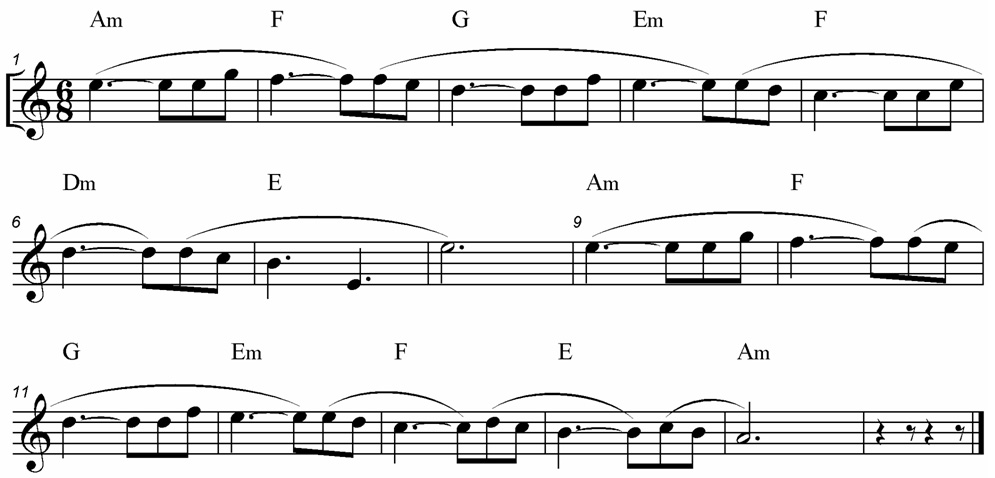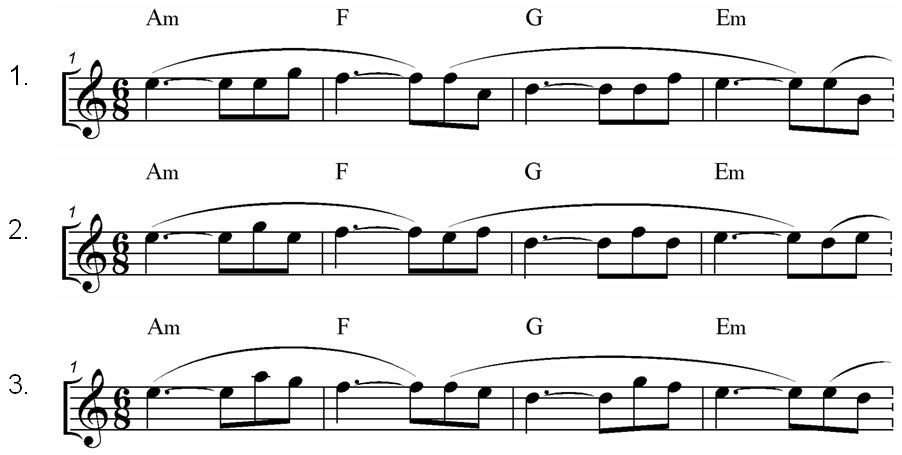The Pyramids Variations
Descending Variations
See if you can play the Pyramids variation suggested in this grid.

Both hands play the same pattern (T M B) all the way through the chord sequence. The right hand plays before the left hand, so you play the six notes from the highest to the lowest.

The ‘developed melody’ can easily be added at the top of this pattern.

Finish
this A1A2 Pyramids version as follows.
Developing the melody
This descending chord pattern provides an ideal opportunity to develop the simple Pyramids melody in the same we as we developed the bass line, using the same or very similar approach movement patterns as before.

Analyse the following melody line for movement types, and play it over the Descending Variations descending chord pattern. It’s a two-bar pattern.

Now look at the following three patterns.

All of these are two-bar patterns – the odd-numbered bars are the same, and the even-numbered bars are the same. Decide what the pattern is, and finish the three 16-bar A1A2 variations.
Here are two variations with more 'approach notes', using the rhythmic pattern of the developed melody.

Study the examples until you can see the pattern, and finish the variations.
A 32-bar AABA version
The Descending Variation is one of several which have been 'officially' extended to full 32-bar AABA length by applying the pattern to the B section material.
The MS for a full 32-bar AABA ‘Descending Variation’ is in your workbook. Here is the audio performance file and MS-plus MidiPiano video.
You will be invited later on to try applying all the variations patterns to the B section material to make full 32-bar AABA versions. Study this variation carefully to see how you might go about it.
|
OUT NOW! |
THE MUSICARTA BEAT & RHYTHM WORKBOOK At last! An effective approach to keyboard rhythm & syncopation skills. Learn more! |
ONLY $24.95! |
PYRAMIDS
|
The MusicartaA methodical approach to keyboard syncopation for
|
PUBLICATIONS
exciting keyboard
creativity courses
CHORDS 101
WORKBOOK

~HANON~
video course

Musicarta
Patreon
PENTATONICS
WORKBOOK
video course

Creative Keyboard
video course

BEAT AND RHYTHM
WORKBOOK

- Volume 1 -

12-BAR PIANO
STYLES WORKBOOK

MUSICARTA MODES
WORKBOOK

PIANO STYLE

CANON PROJECT
video course

VARIATIONS
video course


- Piano Solo -
video course

- Piano Solo -


YouTube playlists





 THE LOGO
THE LOGO
